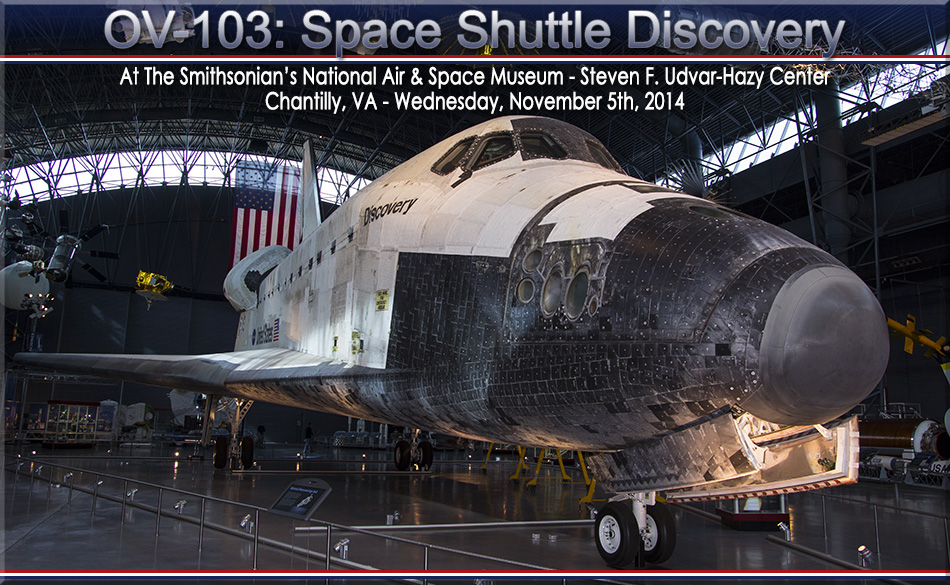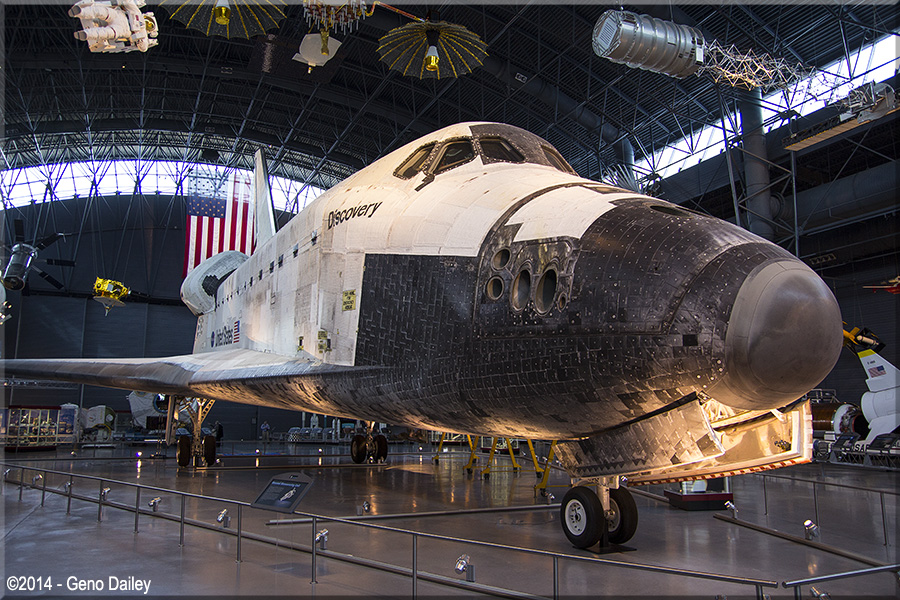 |
 |
 |
 |
The Smithsonian's National Air & Space Museum - Steven F. Udvar-Hazy Center is located in Chantilly, VA near Washington-Dulles International Airport and features a very impressive collection of military and commercial aircraft. Among the huge collection is the Boeing B-29 Superfortress "Enola Gay", along with a Lockheed SR-71 Blackbird. You'll also find a former Air France Concorde on display as well and those are just a few examples of the many dozens of aircraft you'll find here. You could easily spend a couple days checking out everything this place has to offer. My reason of course for being here today was to see Space Shuttle Discovery! The shuttle is located in the James S. McDonnell Space Hangar at the museum.
According to NASA, Space Shuttle Discovery was named after one of the two ships used by British Explorer Captain James Cook when he discovered Hawaii and explored Alaska and Northwestern Canada in the 1770's. Its first mission was STS-41D which launched on August 30th, 1984. Discovery flew 39 missions in its career with its final being STS-133 which launched on February 24th, 2011, having flown a total of 148,221,675 miles. It was also the first shuttle to be retired. The shuttle is situated set up looking as if it had just landed after a mission with the landing gear down and covered in "space dirt", and you can stand very close to it but can't quite touch it! On display around it are several other space-related displays, you could spend a ton of time here checking out everything! And the best part, admission to this museum is free, though cash donations are always welcome.
I arrived here getting a ride from the hotel shuttle van (I cannot say enough great things about this hotel, they drove me back and forth to the airport and to this museum for free, though I always gave a tip!), and would spend a few hours here, having arranged a late checkout from the hotel so as to fit in this visit to see Discovery. Included is some interesting trivia about the shuttle along with photos taken during this visit to this true one-of-a-kind museum!!!
|
|
 |
 |
 |
 |
 |
 |
 |
 |
| As you walk into the James S. McDonnell Space Hangar, this is how you see the shuttle, looking straight at you! |
| |
 |
| Looking like she just got back from another successful mission, here she is, Space Shuttle Discovery! |
| |
|
Another front view of the shuttle, from an alternate angle. The front nose of the shuttle was protected by Reinforced Carbon-Carbon to protect it from
the most extreme temperatures upon re-entry into the earth's atmosphere. This same covering is also on the tips of the wings for the same reason.
|
| |
|
| Discovery's Crew Hatch for entry into the Crew Compartment. |
| |
|
| A view towards the back of the shuttle. |
| |
|
The Shuttle Remote Manipulator System (SRMS), also known as the "Canadarm" which is a robotic arm that was used to lift cargo out of the shuttle's
payload bay while in space. It was created by Canadian aerospace company SPAR Aerospace
and bears the Canada wordmark logo. |
| |
|
| A rear view of this absolutely enormous spacecraft! |
| |
|
The shuttle's 3 main rocket engines! Believe it or not, they would use all the fuel in the orange external tank in just the first 8 1/2 minutes after liftoff!!!
The 2 smaller engines up top were part of the Orbital Maneuvering System (OMS) were used for its final push into orbit, changing of velocity or
altitude within space as well as for starting the decent home.
|
| |
|
The 2 rear landing gear on the shuttle, featuring excellent Michelin tires!!! The square tiles on the undercarriage of the shuttle protected it from the
extreme temperatures the shuttle would encounter upon re-entry into the earth's atmosphere.
|
| |
|
| A side view of the rear of the shuttle from the other side. The huge bulge towards the left of the photo is one of the Orbital Maneuvering System's engines. |
| |
|
| The area towards the front of the shuttle that could be cut open for emergency rescue if necessary. |
| |
|
| The shuttle has a 78ft wingspan! The edges of the wings feature Elevons which are flaps that are used in decent as well as landing. |
| |
|
This photo brought to you courtesy of the wide-angle lens!!! You'll need one if you want to photograph the entire shuttle in the same frame!
The shuttle is actually 122ft long and when connected to the external tank and solid rocket boosters, altogether it measured 184ft!
|
| |
|
The astronaut in the upper left of the photo would probably say "Hi From Space" if it were real and not a prop! The recessed round areas on the nose were
called "Star Trackers" and were used as celestial navigation instruments used for determining the orbiter's position.
|
| |
|
| An overhead view of the shuttle from inside the main hangar at the Steven F. Udvar-Hazy Center. |
| |
|
| I needed proof I was here! |
| |
|
| A Spacelab Laboratory Module. This was a lab used in space that was transported in the payload bay of the shuttle. |
| |
|
| The Lockheed SR-71 Blackbird, a supersonic reconnaissance plane. Imagine flying at Mach 2, or twice the speed of sound!!! This plane did it! |
| |
|
| Boeing B-29 Superfortress "Enola Gay". This plane dropped the first atomic bomb on Hiroshima, Japan in World War II. |
| |
|
| A Boeing 707 demonstrator plane among the many pieces of commercial aircraft on display! |
| |
|
| The Concorde, this time painted up for Air France. This was the second Concorde I would see on this trip! |
 |
|
 |
 |
 |
After an amazing visit to see Discovery, I would have a very quick lunch at McDonald's in the museum before getting the shuttle van back to the hotel. I would be leaving for Florida tonight on Amtrak's Train #97 - The Silver Meteor. Special thanks to NASA and the Smithsonian's National Air & Space Museum for information contained here about the shuttle. Included below is a link to the Air & Space Museum's official web site for more information on one of the most incredible aviation museums anywhere in the world! And without further delay, let's head to Florida as there's another shuttle waiting for me there!!!
|
|
 |
 |
 |
 |
 |
 |
 |
 |
    |